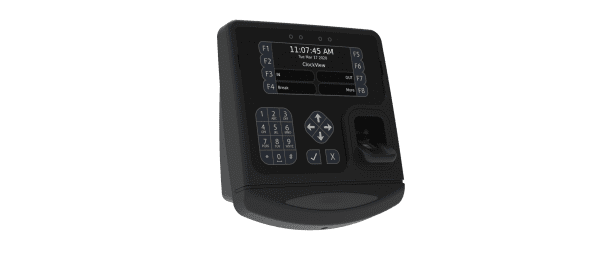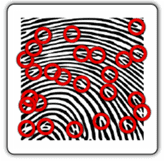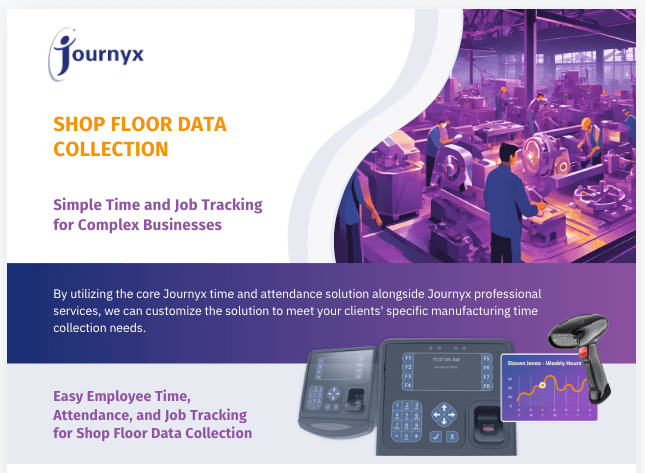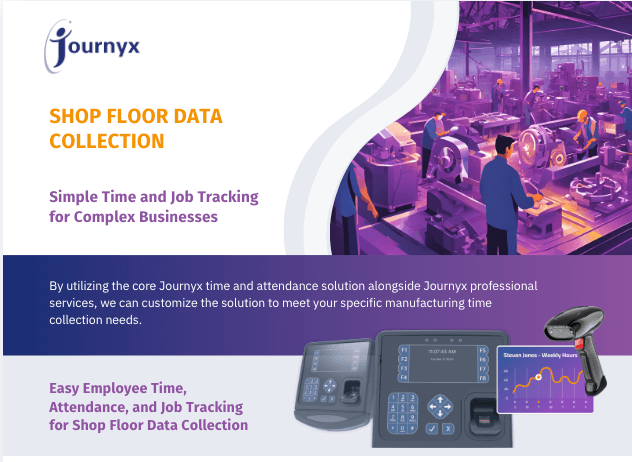Biometric Time Clocks: How Do They Work?
Why use a Fingerprint Biometric Time Clock?
Biometric employee time management solutions, such as fingerprint time clocks, are on the rise for many reasons. These specialized timekeeping devices help manage/control employee access, eliminate time theft, improve business security, and make clocking in and out faster and more efficient than any other time and attendance system. In this post, we’ll take a deeper look at these benefits, as well as how biometric time clock systems were developed and how they work.
What is a Biometric Time Clock?
Biometric time clocks are effective tools for accurately tracking and managing hourly wages, using fingerprint sensors or other biological characteristic analyses to authenticate data. Biometric clocking systems work by measuring some unique aspect of an employee (such as the minutia points on their finger, or the pattern of their iris) and using those measurements to verify the employee. Biometric fingerprint identification provides an added level of security to traditional verification methods, such as using a PIN or employee ID badge.
Are Biometric Time Clocks Easy to Set Up and Use?
Biometric time clocks are very easy to set up and use. Although some might expect that advanced biometric time clocks might be difficult to operate, nothing could be further from the truth.
Biometric Employee Enrollment
 Our GT450 time clock offers an efficient biometric fingerprint scanner to make clocking in fast and secure. This is a fully-featured model with accurate and reliable biometric options. Enrolling employees in a biometric system is as easy as following 5 simple steps, as outlined below.
Our GT450 time clock offers an efficient biometric fingerprint scanner to make clocking in fast and secure. This is a fully-featured model with accurate and reliable biometric options. Enrolling employees in a biometric system is as easy as following 5 simple steps, as outlined below.
- Log in to the time clock as a supervisor.
- Select “Profiles” and enter the identification number for the employee you want to enroll.
- Select “Biometric” and then select “Enroll”.
- Have the employee place their finger on the fingerprint scanner.
- Confirm the fingerprint scan.
And that is all you need to do. The clock will take that scan and produce a biometric profile for the employee automatically. This profile will be used to clock that employee in when they press their finger to the scanner.
Ease of Use
Finger-scanning time clocks are far faster and easier to use than traditional time clock systems. No special technical knowledge is required to operate a biometric time clock, which means that an employee in any field with any level of technical prowess can quickly learn how to clock in and out with a biometric system.
With Journyx’s biometric time clocks, clocking in or out is as simple as pressing a single button and scanning an employee’s finger. Not having to remember and manually punch in credentials or swipe an employee ID badge expedites the time tracking process. This saves time and increases employee productivity, while also preventing common errors that occur with traditional time clock systems.
Journyx’s biometric time clocks were designed to make them as easy as possible for employees to use. Overall, the amount of difficulty involved in using biometric time clocks is limited and the high configurability allows businesses to customize the experience to cater to their needs.
What can a Biometric Time Clock Do for Your Business?
Biometric time clocks use a unique physical attribute – including fingerprints, iris scans, or facial recognition – to confirm employees’ identities and provide an unparalleled time and attendance solution. The benefits of biometric time clocks can be broken down into four categories:
1. Controlling Workplace Access
Biometric time clocks offer a quality of workplace access control that is impossible to achieve using other technology. If you’re planning to pair access control with your employee and attendance solution, biometric time clocks are the perfect fit. With the press of a single finger, an employee can confirm their identity, clock in for work, and open the door. Biometric time clocks can be configured by your business to only allow certain employees into certain rooms. This sort of solution is ideal for businesses that value efficiency and ensures your employees are at the right place at the right time.
2. Eliminating Time Theft
Traditional time clocks are easy for employees to abuse, intentionally or by mistake. Biometric time clocks prevent “buddy-punching” (where one employee uses the PIN or ID card of another employee to clock them in when they aren’t working) by requiring any employee to be physically authenticated by the time clock system. Additionally, these clocks make it quicker and easier for employees to clock in and out, which means your employees are more likely to follow time tracking procedures and reduce any potentially wasted time spent figuring out how to clock in or out for a shift or a break.
3. Improving Business Security
There is no greater security than immediate physical security, and there is no better way to ensure that physical security than biometric authorization. Not only are they the best option for controlled access and employee authentication, but biometric time clocks also ensure your business remains secure. Biometric technology can keep your customers out of spaces designated for employees, track employee movement, and even prevent trespassing and theft. If your business uses biometric security measures, your employees and property are always safe. While a lock key, access code, or security card could be stolen or misused, biometric time clocks cannot be bypassed this way. The use of biometric devices is logged and recorded, so you will know exactly who is using any device, any time it is used.
4. Increasing Employee Efficiency
Biometric time and attendance systems vastly improve employee efficiency compared to traditional time clocks. These systems are easy to set up, easy to use for your employees and managers, and save your business time and money. Biometric time clocks work best with automated time and attendance software to minimize employee error and increase individual efficiency. The less time your company spends verifying time cards and employee work hours, the more money you save. Plus, since biometric systems are reliable and easy to use, your employees will save time clocking in and out and be able to focus more on their work.
How were Biometric Time Clocks Developed?
People have used unique physical qualities to identify each other for thousands of years, but it was not until the 1970’s that biometric devices became commercially available. With a significant push from the U.S. government to automate the time-consuming work of comparing fingerprint time cards by hand, new technology that automated biometric verification flourished. Throughout the late 80’s and early 90’s, a number of groundbreaking patents were awarded for methods for identifying people by their hand shapes, vascular patterns, iris patterns, and face shapes. Later developments led to the standardization of protocols for matching fingerprint minutia points and other unique personal measurements.
While biometric technology originated as a tool for law enforcement, over time, it became specialized for personal employee identification, access control, and workforce time and attendance. Some of the most popular techniques for biometric time and attendance include fingerprint minutia scanning, iris pattern matching, and face recognition.
Today, biometric time clock systems are seen as the industry standard because of their reliability and clear advantages over traditional employee time clocks.
How Secure are Biometric Time Clocks?
Biometric systems are far more secure than traditional pin or employee ID card systems. Inherently, a biometric system eliminates the possibility of clocking in or out for another employee by ensuring that each employee is only able to punch in and out using their own fingerprint. If an employee would be behind schedule or absent, another employee cannot fraudulently clock them in. This same technology prevents employees from swapping shifts without a supervisor’s approval and ensures accountability for employees arriving late or clocking out early.
Our biometric systems were designed with user privacy in mind. The technology utilized by these biometric systems cannot be used for any purposes other than time and attendance or access control. Fingerprint scans are discarded immediately after they are used for employee enrollment, and biometric templates are anonymized and tied exclusively to employee reference numbers. No personal information is ever saved in the system, so there is no risk of sensitive information being compromised.
Your business can be certain that Journyx provides the highest level of privacy and security with its biometric time clock solutions.
How Does a Fingerprint Time Clock Work?
When the system is set up, employees using biometric time clock authentication are enrolled by initially scanning their fingerprints. Using this scan, the system identifies sections of the fingerprint where ridges and grooves intersect or terminate. The product of this enrollment process is an employee’s biometric template. Once the biometric template has been created, the original scan of the employee’s fingerprint is discarded, and only the template is saved for future reference.
This enrollment process is detailed in the following diagram:
 |
 |
 |
| First, an employee’s fingerprint is scanned into the system. | Next, the system identifies intersections and terminations. | Finally, an employee’s unique biometric template is created. |
When an employee uses a biometric time clock, their fingerprint is quickly scanned and cross-referenced with the biometric templates that are saved in the system. If there is a match between the fingerprint and the template, the system accurately identifies the employee and allows them to clock in or out. If there is no match between the fingerprint and any template in the system, access to the time clock is denied.
Experts in Timekeeping and Employee Scheduling
Journyx provides powerful time tracking solutions that help organizations easily and accurately track employee time for projects, billing, and payroll.
We help companies streamline timesheet collection and processing, improve cost accounting, optimize labor resources, and get a clearer picture of where time and money are being spent.
With our time and attendance product line, Journyx also offers state-of-the-art physical time clocks and cloud-based employee scheduling software that allows your team to manage time and attendance from anywhere.
Contact us today for more information about our biometric time clocks and to schedule a customized demo!
Let’s Get Started. Book a Demo Today.
Journyx helps you track time for projects, payroll, and more. Learn how Journyx can help you use time to your advantage in your business.



